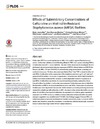Identificador persistente para citar o vincular este elemento:
https://accedacris.ulpgc.es/jspui/handle/10553/47221
| Campo DC | Valor | idioma |
|---|---|---|
| dc.contributor.author | Lazaro-Diez, Maria | en_US |
| dc.contributor.author | Remuzgo-Martinez, Sara | en_US |
| dc.contributor.author | Rodriguez-Mirones, Cristina | en_US |
| dc.contributor.author | Acosta, Felix | en_US |
| dc.contributor.author | Icardo, Jose M. | en_US |
| dc.contributor.author | Martinez-Martinez, Luis | en_US |
| dc.contributor.author | Ramos Vivas, Jose | en_US |
| dc.date.accessioned | 2018-11-23T11:48:14Z | - |
| dc.date.available | 2018-11-23T11:48:14Z | - |
| dc.date.issued | 2016 | en_US |
| dc.identifier.issn | 1932-6203 | en_US |
| dc.identifier.other | WoS | - |
| dc.identifier.other | Scopus | - |
| dc.identifier.uri | https://accedacris.ulpgc.es/handle/10553/47221 | - |
| dc.description.abstract | Ceftaroline (CPT) is a novel cephalosporin with in vitro activity against Staphylococcus aureus. Ceftaroline exhibits a level of binding affinity for PBPs in S. aureus including PBP2a of methicillin-resistant S. aureus (MRSA). The aims of this study were to investigate the morphological, physiological and molecular responses of MRSA clinical strains and MRSA biofilms to sub-MICs (1/4 and 1/16 MIC) of ceftaroline by using transmission, scanning and confocal microscopy. We have also used quantitative Real-Time PCR to study the effect of sub-MICs of ceftaroline on the expression of the staphylococcal icaA, agrA, sarA and sasF genes in MRSA biofilms. In one set of experiments, ceftaroline was able to inhibit biofilm formation in all strains tested at MIC, however, a strain dependent behavior in presence of sub-MICs of ceftaroline was shown. In a second set of experiments, destruction of preformed biofilms by addition of ceftaroline was evaluated. Ceftaroline was able to inhibit biofilm formation at MIC in all strains tested but not at the sub-MICs. Destruction of preformed biofilms was strain dependent because the biofilm formed by a matrix-producing strain was resistant to a challenge with ceftaroline at MIC, whereas in other strains the biofilm was sensitive. At sub-MICs, the impact of ceftaroline on expression of virulence genes was strain-dependent at 1/4 MIC and no correlation between ceftaroline-enhanced biofilm formation and gene regulation was established at 1/16 MIC. Our findings suggest that sub-MICs of ceftaroline enhance bacterial attachment and biofilm formation by some, but not all, MRSA strains and, therefore, stress the importance of maintaining effective bactericidal concentrations of ceftaroline to fight biofilm-MRSA related infections. | en_US |
| dc.language | eng | en_US |
| dc.relation.ispartof | PLoS ONE | en_US |
| dc.source | PLoS ONE [ISSN 1932-6203], v. 11 (1), (e0147569) (Enero 2016) | en_US |
| dc.subject | 320505 Enfermedades infecciosas | en_US |
| dc.subject.other | In-Vitro | en_US |
| dc.subject.other | Antibiotic Concentrations | en_US |
| dc.subject.other | Inhibitory Concentrations | en_US |
| dc.subject.other | Bactericidal Activity | en_US |
| dc.subject.other | Cell-Wall | en_US |
| dc.subject.other | Epidermidis | en_US |
| dc.subject.other | Expression | en_US |
| dc.subject.other | Agr | en_US |
| dc.subject.other | Mechanisms | en_US |
| dc.subject.other | Penetration | en_US |
| dc.title | Effects of subinhibitory concentrations of ceftaroline on Methicillin-Resistant Staphylococcus aureus (MRSA) biofilms | en_US |
| dc.type | info:eu-repo/semantics/article | en_US |
| dc.type | Article | en_US |
| dc.identifier.doi | 10.1371/journal.pone.0147569 | en_US |
| dc.identifier.scopus | 2-s2.0-84958231161 | - |
| dc.identifier.isi | 000368655300126 | - |
| dc.contributor.authorscopusid | 56407204500 | - |
| dc.contributor.authorscopusid | 47861384300 | - |
| dc.contributor.authorscopusid | 36244271800 | - |
| dc.contributor.authorscopusid | 56269311600 | - |
| dc.contributor.authorscopusid | 7004311013 | - |
| dc.contributor.authorscopusid | 7005458506 | - |
| dc.contributor.authorscopusid | 23493408700 | - |
| dc.identifier.eissn | 1932-6203 | - |
| dc.identifier.issue | e0147569 | - |
| dc.relation.volume | 11 | en_US |
| dc.investigacion | Ciencias de la Salud | en_US |
| dc.type2 | Artículo | en_US |
| dc.contributor.daisngid | 4930153 | - |
| dc.contributor.daisngid | 1031649 | - |
| dc.contributor.daisngid | 7423146 | - |
| dc.contributor.daisngid | 878226 | - |
| dc.contributor.daisngid | 428306 | - |
| dc.contributor.daisngid | 67474 | - |
| dc.contributor.daisngid | 1854108 | - |
| dc.description.numberofpages | 15 | en_US |
| dc.utils.revision | Sí | en_US |
| dc.contributor.wosstandard | WOS:Lazaro-Diez, M | - |
| dc.contributor.wosstandard | WOS:Remuzgo-Martinez, S | - |
| dc.contributor.wosstandard | WOS:Rodriguez-Mirones, C | - |
| dc.contributor.wosstandard | WOS:Acosta, F | - |
| dc.contributor.wosstandard | WOS:Icardo, JM | - |
| dc.contributor.wosstandard | WOS:Martinez-Martinez, L | - |
| dc.contributor.wosstandard | WOS:Ramos-Vivas, J | - |
| dc.date.coverdate | Enero 2016 | en_US |
| dc.identifier.ulpgc | Sí | es |
| dc.description.sjr | 1,201 | |
| dc.description.jcr | 2,806 | |
| dc.description.sjrq | Q1 | |
| dc.description.jcrq | Q1 | |
| dc.description.scie | SCIE | |
| dc.description.erihplus | ERIH PLUS | |
| item.grantfulltext | open | - |
| item.fulltext | Con texto completo | - |
| crisitem.author.dept | GIR Grupo de Investigación en Acuicultura | - |
| crisitem.author.dept | IU de Investigación en Acuicultura Sostenible y Ec | - |
| crisitem.author.dept | Departamento de Patología Animal, Producción Animal, Bromatología y Tecnología de Los Alimentos | - |
| crisitem.author.orcid | 0000-0002-1098-7529 | - |
| crisitem.author.parentorg | IU de Investigación en Acuicultura Sostenible y Ec | - |
| crisitem.author.fullName | Acosta Arbelo, Félix Antonio | - |
| crisitem.author.fullName | Ramos Vivas, José | - |
| Colección: | Artículos | |
Citas SCOPUSTM
44
actualizado el 08-jun-2025
Citas de WEB OF SCIENCETM
Citations
44
actualizado el 08-jun-2025
Visitas
280
actualizado el 06-dic-2025
Descargas
140
actualizado el 06-dic-2025
Google ScholarTM
Verifica
Altmetric
Comparte
Exporta metadatos
Los elementos en ULPGC accedaCRIS están protegidos por derechos de autor con todos los derechos reservados, a menos que se indique lo contrario.
